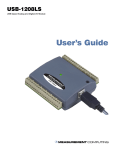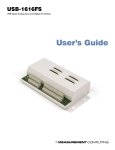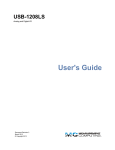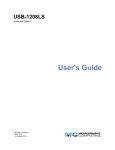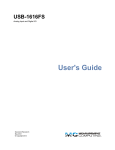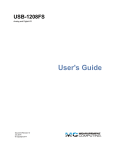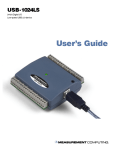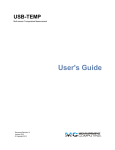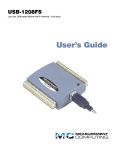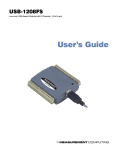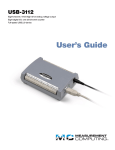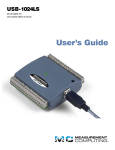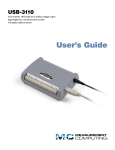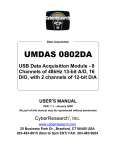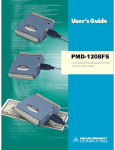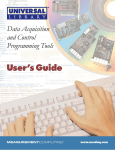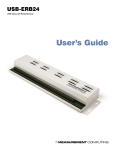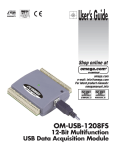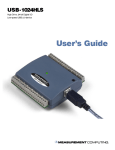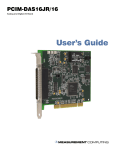Download User`s Manual
Transcript
USB-1608FS USB-based Analog and Digital I/O Module User's Guide Document Revision 2, May, 2006 © Copyright 2006, Measurement Computing Corporation™ Your new Measurement Computing product comes with a fantastic extra — Management committed to your satisfaction! Refer to www.mccdaq.com/execteam.html for the names, titles, and contact information of each key executive at Measurement Computing. Thank you for choosing a Measurement Computing product—and congratulations! You own the finest, and you can now enjoy the protection of the most comprehensive warranties and unmatched phone tech support. It’s the embodiment of our two missions: ! To offer the highest-quality, computer-based data acquisition, control, and GPIB hardware and software available—at the best possible price. ! To offer our customers superior post-sale support—FREE. Whether providing unrivaled telephone technical and sales support on our latest product offerings, or continuing that same first-rate support on older products and operating systems, we’re committed to you! Lifetime warranty: Every hardware product manufactured by Measurement Computing Corporation is warranted against defects in materials or workmanship for the life of the product. Products found defective are repaired or replaced promptly. Lifetime Harsh Environment Warranty®: We will replace any product manufactured by Measurement Computing Corporation that is damaged (even due to misuse) for only 50% of the current list price. I/O boards face some tough operating conditionssome more severe than the boards are designed to withstand. When a board becomes damaged, just return the unit with an order for its replacement at only 50% of the current list price. We don’t need to profit from your misfortune. By the way, we honor this warranty for any manufacturer’s board that we have a replacement for. 30 Day Money Back Guarantee: You may return any Measurement Computing Corporation product within 30 days of purchase for a full refund of the price paid for the product being returned. If you are not satisfied, or chose the wrong product by mistake, you do not have to keep it. Please call for an RMA number first. No credits or returns accepted without a copy of the original invoice. Some software products are subject to a repackaging fee. These warranties are in lieu of all other warranties, expressed or implied, including any implied warranty of merchantability or fitness for a particular application. The remedies provided herein are the buyer’s sole and exclusive remedies. Neither Measurement Computing Corporation, nor its employees shall be liable for any direct or indirect, special, incidental or consequential damage arising from the use of its products, even if Measurement Computing Corporation has been notified in advance of the possibility of such damages. HM USB-1608FS.doc ii Trademark and Copyright Information TracerDAQ, Universal Library, InstaCal, Harsh Environment Warranty, Measurement Computing Corporation, and the Measurement Computing logo are either trademarks or registered trademarks of Measurement Computing Corporation. Windows, Microsoft, and Visual Studio are either trademarks or registered trademarks of Microsoft Corporation LabVIEW is a trademark of National Instruments. CompactFlash is a registered trademark of SanDisk Corporation. All other trademarks are the property of their respective owners. Information furnished by Measurement Computing Corporation is believed to be accurate and reliable. However, no responsibility is assumed by Measurement Computing Corporation neither for its use; nor for any infringements of patents or other rights of third parties, which may result from its use. No license is granted by implication or otherwise under any patent or copyrights of Measurement Computing Corporation. All rights reserved. No part of this publication may be reproduced, stored in a retrieval system, or transmitted, in any form by any means, electronic, mechanical, by photocopying, recording, or otherwise without the prior written permission of Measurement Computing Corporation. Notice Measurement Computing Corporation does not authorize any Measurement Computing Corporation product for use in life support systems and/or devices without prior written consent from Measurement Computing Corporation. Life support devices/systems are devices or systems which, a) are intended for surgical implantation into the body, or b) support or sustain life and whose failure to perform can be reasonably expected to result in injury. Measurement Computing Corporation products are not designed with the components required, and are not subject to the testing required to ensure a level of reliability suitable for the treatment and diagnosis of people. iii Table of Contents Preface About this User's Guide ......................................................................................................................vi What you will learn from this user's guide ........................................................................................................vi Conventions in this user's guide ........................................................................................................................vi Where to find more information ........................................................................................................................vi Chapter 1 Introducing the USB-1608FS............................................................................................................ 1-1 USB-1608FS block diagram........................................................................................................................... 1-2 Software features ............................................................................................................................................ 1-2 Connecting a USB-1608FS to your computer is easy..................................................................................... 1-3 Chapter 2 Installing the USB-1608FS................................................................................................................ 2-1 What comes with your USB-1608FS shipment? ............................................................................................ 2-1 Hardware ....................................................................................................................................................................... 2-1 Additional documentation.............................................................................................................................................. 2-1 Unpacking the USB-1608FS .......................................................................................................................... 2-1 Installing the software .................................................................................................................................... 2-2 Installing the hardware ................................................................................................................................... 2-2 Chapter 3 Functional Details ............................................................................................................................. 3-1 Theory of operation - analog input acquisition modes ................................................................................... 3-1 Software paced mode..................................................................................................................................................... 3-1 Continuous scan mode ................................................................................................................................................... 3-1 Burst scan mode............................................................................................................................................................. 3-1 External components ...................................................................................................................................... 3-2 USB connector............................................................................................................................................................... 3-2 LED ............................................................................................................................................................................... 3-2 Screw terminal wiring.................................................................................................................................................... 3-3 Main connector and pin out ........................................................................................................................................... 3-3 Analog input terminals (CH0 IN - CH7 IN)................................................................................................................... 3-4 Digital I/O terminals (DIO0 to DIO7)............................................................................................................................ 3-5 Power terminals ............................................................................................................................................................. 3-6 Ground terminals ........................................................................................................................................................... 3-6 Calibration terminal ....................................................................................................................................................... 3-7 Counter terminal ............................................................................................................................................................ 3-7 SYNC terminal .............................................................................................................................................................. 3-7 Trigger terminal ............................................................................................................................................................. 3-7 Accuracy......................................................................................................................................................... 3-7 Gain queue.................................................................................................................................................... 3-10 Synchronizing multiple units........................................................................................................................ 3-10 Chapter 4 Specifications.................................................................................................................................... 4-1 Analog input section....................................................................................................................................... 4-1 Digital input/output......................................................................................................................................... 4-2 External trigger ............................................................................................................................................... 4-2 External clock input/output............................................................................................................................. 4-3 Counter section ............................................................................................................................................... 4-3 Memory .......................................................................................................................................................... 4-3 Microcontroller............................................................................................................................................... 4-4 iv USB-1608FS User's Guide Power.............................................................................................................................................................. 4-4 General ........................................................................................................................................................... 4-4 Environmental ................................................................................................................................................ 4-4 Mechanical ..................................................................................................................................................... 4-4 Main connector and pin out ............................................................................................................................ 4-5 v Preface About this User's Guide What you will learn from this user's guide This user's guide explains how to install, configure, and use the USB-1608FS so that you get the most out of its USB data acquisition features. This user's guide also refers you to related documents available on our web site, and to technical support resources. Conventions in this user's guide For more information on … Text presented in a box signifies additional information and helpful hints related to the subject matter you are reading. Caution! Shaded caution statements present information to help you avoid injuring yourself and others, damaging your hardware, or losing your data. <#:#> Angle brackets that enclose numbers separated by a colon signify a range of numbers, such as those assigned to registers, bit settings, etc. bold text Bold text is used for the names of objects on the screen, such as buttons, text boxes, and check boxes. For example: 1. Insert the disk or CD and click the OK button. italic text Italic text is used for the names of manuals and help topic titles, and to emphasize a word or phrase. For example: The InstaCal® installation procedure is explained in the Quick Start Guide. Never touch the exposed pins or circuit connections on the board. Where to find more information The following electronic documents provide helpful information relevant to the operation of the USB-1608FS. ! ! ! ! ! ! MCC's Specifications: USB-1608FS (the PDF version of the Electrical Specification Chapter in this guide) is available on our web site at www.mccdaq.com/pdfs/USB-1608FS.pdf. MCC's Quick Start Guide is available on our web site at www.mccdaq.com/PDFmanuals/DAQ-Software-Quick-Start.pdf. MCC's Guide to Signal Connections is available on our web site at www.mccdaq.com/signals/signals.pdf. MCC's Universal Library User's Guide is available on our web site at www.mccdaq.com/PDFmanuals/sm-ul-user-guide.pdf. MCC's Universal Library Function Reference is available on our web site at www.mccdaq.com/PDFmanuals/sm-ul-functions.pdf. MCC's Universal Library for LabVIEW™ User’s Guide is available on our web site at www.mccdaq.com/PDFmanuals/SM-UL-LabVIEW.pdf. USB-1608FS User's Guide (this document) is also available on our web site at www.mccdaq.com/PDFmanuals/USB-1608FS.pdf. vi Chapter 1 Introducing the USB-1608FS This user's guide contains all of the information you need to connect the USB-1608FS to your computer and to the signals you want to measure. The USB-1608FS is part of the Measurement Computing brand of USB-based data acquisition products. The USB-1608FS is a USB 2.0 full-speed device supported under popular Microsoft® Windows® operating systems. It is designed for USB 1.1 ports, and was tested for full compatibility with both USB 1.1 and USB 2.0 ports. The USB-1608FS offers true simultaneous sampling of up to eight channels of 16-bit single-ended analog input. This is accomplished through the use of one A/D converter per channel. The range of each channel is independently configurable via software. Eight digital IO lines are independently selectable as input or output. A 32-bit counter is capable of counting TTL pulses. The USB-1608FS is powered by the +5 volt USB supply from your computer. No external power is required. A SYNC (synchronization) control line allows you to synchronize two USB-1608FS modules together to acquire data synchronously from 16 analog inputs. The USB-1608FS is shown in Figure 1-1. I/O connections are made to the screw terminals located along each side of the USB-1608FS. Figure 1-1. USB-1608FS 1-1 USB-1608FS User's Guide Introducing the USB-1608FS USB-1608FS block diagram USB-1608FS functions are illustrated in the block diagram shown here. USB G= 1, 2, 5, 10 Full-speed USB 2.0 Compliant Interface A/D 0 32k x 16 SRAM A/D 1 16 16 Screw terminal I/O connector 16 A/D 3 DIO 8 A/D 4 SPI SYNC A/D 5 USB Microcontroller TRIG_IN CAL Screw terminal I/O connector A/D 2 A/D 6 CAL A/D 7 32-bit Event Counter 1 channel Figure 1-2. USB-1608FS Functional Block Diagram Software features For information on the features of InstaCal and the other software included with your USB-1608FS, refer to the Quick Start Guide that shipped with your device. The Quick Start Guide is also available in PDF at www.mccdaq.com/PDFmanuals/DAQ-Software-Quick-Start.pdf. Check www.mccdaq.com/download.htm for the latest software version or versions of the software supported under less commonly used operating systems. 1-2 USB-1608FS User's Guide Introducing the USB-1608FS Connecting a USB-1608FS to your computer is easy Installing a data acquisition device has never been easier. ! ! ! ! ! ! The USB-1608FS relies upon the Microsoft Human Interface Device (HID) class drivers. The HID class drivers ship with every copy of Windows that is designed to work with USB ports. We use the Microsoft HID because it is a standard, and its performance delivers full control and maximizes data transfer rates for your USB-1608FS. No third-party device driver is required. The USB-1608FS is plug-and-play. There are no jumpers to position, DIP switches to set, or interrupts to configure. You can connect the USB-1608FS before or after you install the software, and without powering down your computer first. When you connect an HID to your system, your computer automatically detects it and configures the necessary software. You can connect and power multiple HID peripherals to your system using a USB hub. You can connect your system to various devices using a standard four-wire cable. The USB connector replaces the serial and parallel port connectors with one standardized plug and port combination. You do not need a separate power supply module. The USB automatically delivers the electrical power required by each peripheral connected to your system. Data can flow two ways between a computer and peripheral over USB connections. 1-3 Chapter 2 Installing the USB-1608FS What comes with your USB-1608FS shipment? The following items are shipped with the USB-1608FS. Hardware ! USB-1608FS ! USB cable (2 meter length) Additional documentation In addition to this hardware user's guide, you should also receive the Quick Start Guide (available in PDF at www.mccdaq.com/PDFmanuals/DAQ-Software-Quick-Start.pdf). This booklet supplies a brief description of the software you received with your USB-1608FS and information regarding installation of that software. Please read this booklet completely before installing any software or hardware. Unpacking the USB-1608FS As with any electronic device, you should take care while handling to avoid damage from static electricity. Before removing the USB-1608FS from its packaging, ground yourself using a wrist strap or by simply touching the computer chassis or other grounded object to eliminate any stored static charge. If any components are missing or damaged, notify Measurement Computing Corporation immediately by phone, fax, or e-mail: ! ! ! Phone: 508-946-5100 and follow the instructions for reaching Tech Support. Fax: 508-946-9500 to the attention of Tech Support Email: [email protected] 2-1 USB-1608FS User's Guide Installing the USB-1608FS Installing the software Refer to the Quick Start Guide for instructions on installing the software on the Measurement Computing Data Acquisition Software CD. This booklet is available in PDF at www.mccdaq.com/PDFmanuals/DAQ-SoftwareQuick-Start.pdf. Installing the hardware Be sure you are using the latest system software Before you connect the USB-1608FS, make sure that you are using the latest versions of the USB drivers. Before installing the USB-1608FS, download and install the latest Microsoft Windows updates. In particular, when using Windows XP, make sure you have XP Hotfix KB822603 installed. This update is intended to address a serious error in Usbport.sys when you operate a USB device. You can run Windows Update or download the update from www.microsoft.com/downloads/details.aspx?familyid=733dd867-56a0-4956-b7fee85b688b7f86&displaylang=en. For more information, refer to the Microsoft Knowledge Base article "Availability of the Windows XP SP1 USB 1.1 and 2.0 update." This article is available at support.microsoft.com/?kbid=822603. To connect the USB-1608FS to your system, turn your computer on, and connect the USB cable to a USB port on your computer or to an external USB hub that is connected to your computer. The USB cable provides power and communication to the USB-1608FS. The USB-1608FS installs as a composite device with separate devices attached. When you connect the USB1608FS for the first time, Found New Hardware popup balloons (Windows XP) or dialogs (other Windows version) open as each USB-1608FS interface is detected. It is normal for multiple dialogs to open when you connect the USB-1608FS for the first time. For additional information, refer to the "Notes on installing and using the USB-1608FS" that was shipped with the USB1608FS. When the last balloon or dialog closes, the installation is complete. The LED on the USB-1608FS should flash and then remain lit. This indicates that communication is established between the USB-1608FS and your computer. Caution! Do not disconnect any device from the USB bus while the computer is communicating with the USB-1608FS, or you may lose data and/or your ability to communicate with the USB-1608FS. If the LED turns off If the LED is lit but then turns off, the computer has lost communication with the USB-1608FS. To restore communication, disconnect the USB cable from the computer, and then reconnect it. This should restore communication, and the LED should turn back on. 2-2 Chapter 3 Functional Details Theory of operation - analog input acquisition modes The USB-1608FS can acquire analog input data in three basic modes – software paced, continuous scan, and burst scan. Software paced mode You can acquire one analog sample at a time in software paced mode. You initiate the A/D conversion by calling a software command. The analog value is converted to digital data and returned to the computer. You can repeat this procedure until you have the total number of samples that you want from one channel. The maximum throughput sample rate in software paced mode is system-dependent. Continuous scan mode You can acquire data from up to eight channels simultaneously in continuous scan mode. The analog data is continuously acquired, converted to digital values, and written to an on-board FIFO buffer on the USB-1608FS until you stop the scan. The FIFO buffer is serviced in blocks as the data is transferred from the USB-1608FS FIFO buffer to the memory buffer on your computer. The maximum sampling rate is an aggregate rate, where the total sample rate for all channels is 100 kS/s divided by the number of channels, with a maximum rate of 50 kS/s for any channel. Using this equation, you can acquire data with the USB-1608FS from one channel at 50 kS/s, two channels at 50 kS/s each, four channels at 25 kS/s each, and so on, up to eight channels at 12.5 kS/s each. You can start a continuous scan with either a software command or with an external hardware trigger event. Burst scan mode In burst scan mode, you can acquire data with the USB-1608FS using the full capacity of its 32 K sample FIFO. The acquired data is then read from the FIFO and transferred to a user buffer in your computer. You can initiate a single acquisition sequence of one, two, four, or eight channels by either a software command or an external hardware trigger. Burst scans are limited to the depth of the on-board memory, as the data is acquired at a rate faster than it can be transferred to the computer. The maximum sampling rate is an aggregate rate, where the total acquisition rate for all channels is 200 kS/s divided by the number of channels, with a maximum rate of 50 kS/s for any channel. The maximum rate that you can acquire data using burst scan mode is 50 kS/s each for one, two, or four channels, and 25 kS/s each for eight channels. 3-1 USB-1608FS User's Guide Functional Details External components The USB-1608FS has the following external components, as shown in Figure 3-1. ! ! ! USB connector LED Screw terminal banks (2) Screw terminal Pins 1 to 20 LED Screw terminal Pins 21 to 40 USB connector / cable Figure 3-1. USB-1608FS USB connector The USB connector is on the right side of the USB-1608FS. This connector provides +5 V power and communication. The voltage supplied through the USB connector is system-dependent, and may be less than 5 V. No external power supply is required. LED The LED on the front of the USB-1608FS indicates the communication status. It uses up to 5 mA of current and cannot be disabled. Table 3-1 explains the function of the USB-1608FS LED. Table 3-1 LED Illumination When the LED is… It indicates… Steady green Blinks continuously Blinks three times Blinks at a slow rate The USB-1608FS is connected to a computer or external USB hub. Data is being transferred. Initial communication is established between the USB-1608FS and the computer. The analog input is configured for external trigger. The LED stops blinking and illuminates steady green when the trigger is received. 3-2 USB-1608FS User's Guide Functional Details Screw terminal wiring The USB-1608FS has two rows of screw terminals—one row on the top edge of the housing, and one row on the bottom edge. Each row has 20 connections. Pin numbers are identified in Figure 3-2. Figure 3-2. USB-1608FS screw terminal pin numbers Screw terminal – pins 1-20 The screw terminals on the top edge of the USB-1608FS (pins 1 to 20) provide the following connections: ! ! ! Eight analog input connections (CH0 IN to CH7 IN) Eleven analog ground connections (AGND) One calibration output terminal (CAL) Screw terminal – pins 21-40 The screw terminals on the bottom edge of the USB-1608FS (pins 21 to 40) provide the following connections: ! ! ! ! ! ! Eight digital I/O connections (DIO0 to DIO7) One external trigger source (TRIG_IN) One external event counter connection (CTR) One power connection (PC+5 V) One SYNC terminal for external clocking and multi-unit synchronization (SYNC) Eight ground connections (GND) Main connector and pin out Connector type Wire gauge range Screw terminal 16 AWG to 30 AWG 3-3 Functional Details GND PC +5V CTR TRIG_IN SYNC DIO7 GND DIO6 GND DIO5 GND DIO4 GND DIO3 GND DIO2 GND DIO1 GND DIO0 40 39 38 37 36 35 34 33 32 31 30 29 28 27 26 25 24 23 22 21 20 19 18 17 16 15 14 13 12 11 10 9 8 7 6 5 4 3 2 1 AGND AGND AGND CAL AGND CH7 IN AGND CH6 IN AGND CH5 IN AGND CH4 IN AGND CH3 IN AGND CH2 IN AGND CH1 IN AGND CH0 IN USB-1608FS User's Guide Analog input terminals (CH0 IN - CH7 IN) You can connect up to eight analog input connections to the screw terminal containing pins 1 to 20 (CH0 IN through CH7 IN.) Refer to the pinout diagram on page 3-3 for the location of these pins. We recommend that you connect unused analog input terminals to ground terminals during operation. For example, if you are not using terminal 15 (CH7 IN), connect this terminal to terminal 16 (AGND). Input configuration All of the analog input channels are configured for single-ended input mode. Each analog signal is referenced to signal ground (AGND), and requires two wires: ! ! The wire carrying the signal to be measured connects to CH# IN. The second wire connects to AGND. The input voltage ranges are ±10 V, ±5 V, ±2.0 V, ±1.0 V. The following image illustrates a typical singleended measurement connection. Pin 2 AGND Pin 1 CH0 IN Figure 3-3. Single-Ended measurement connection 3-4 USB-1608FS User's Guide Functional Details The following image shows the single-ended measurement data acquired by TracerDAQ. Figure 3-4. TracerDAQ showing single-ended measurement data For more information on analog signal connections For more information on single-ended inputs, refer to the Guide to Signal Connections (this document is available on our web site at www.mccdaq.com/signals/signals.pdf). Digital I/O terminals (DIO0 to DIO7) You can connect up to eight digital I/O lines to the screw terminal containing pins 21 to 40 (DIO0 to DIO7). Refer to the pinout diagram on page 3-3 for the location of these pins. You can configure each digital bit for either input or output. All digital I/O lines are pulled up to USB +5 V with a 47 K resistor (default). You can request the factory to configure the resistor for pull-down to ground if desired. When you configure the digital bits for input, you can use the USB-1608FS digital I/O terminals to detect the state of any TTL-level input. Refer to the switch circuit shown in Figure 3-5 and the schematic shown in Figure 3-6. If you set the switch to the +5 V input, DIO0 reads TRUE (1). If you move the switch to GND, DIO0 reads FALSE (0). Pin 21 DIO0 Pin 39 PC +5V Pin 40 GND Figure 3-5. Digital connection DIO0 detecting the state of a switch 3-5 USB-1608FS User's Guide Functional Details DIO0 +GND +5V Figure 3-6. Schematic showing switch detection by digital channel DIO0 For more information on digital signal connections For general information regarding digital signal connections and digital I/O techniques, refer to the Guide to Signal Connections (available on our web site at www.mccdaq.com/signals/signals.pdf). Power terminals The PC +5 V connection (pin 39) is on the bottom screw terminal of the USB-1608FS. Refer to the pinout diagram on page 3-3 for the location of this pin. This terminal draws power from the USB connector. The +5 V screw terminal is a 5 volt output that is supplied by the computer. Caution! The +5 V terminal is an output. Do not connect to an external power supply or you may damage the USB-1608FS and possibly the computer. The maximum total output current that can be drawn from all USB-1608FS connections (power, analog, and digital outputs) is 500 mA. This maximum applies to most personal computers and self-powered USB hubs. Bus-powered hubs and notebook computers may limit the maximum available output current to 100 mA. The USB-1608FS alone draws 150 mA of current from the USB +5 V supply. Once you start running applications with the USB-1608FS, each DIO bit can draw up to 2.5 mA. The maximum amount of +5 V current available for experimental use, over and above that required by the USB-1608FS, is the difference between the total current requirement of the USB-1608FS (based on the application), and the allowed current draw of the computer platform (500 mA for desktop computers and self-powered hubs). With all outputs at their maximum output current, you can calculate the total current requirement of the USB1608FS USB +5 V as follows: (USB-1608FS @ 150 mA) + (8 DIO @ 2.5 mA ea) = 170 mA For an application running on a computer or powered hub, the maximum available excess current is 500 mA − 170 mA = 330 mA. This number is the total maximum available current at the PC+5 V screw terminals. Measurement Computing highly recommends that you figure in a safety factor of 20% below this maximum current loading for your applications. A conservative, safe user maximum in this case would be in the 250300 mA range. Since some laptop computers running on battery power only allow up to 100 mA, the USB-1608FS may be above that allowed by the computer. In this case, you must either purchase a self-powered hub or operate the laptop computer from an external power adapter. Ground terminals The 11 analog ground connections provide a common ground for all USB-1608FS input channels. Eight ground connections provide a common ground for the DIO, TRIG_IN, CTR, SYNC and PC +5 V connections. Refer to the pinout diagram on page 3-3 for the location of the AGND and GND terminal pins. 3-6 USB-1608FS User's Guide Functional Details Calibration terminal The CAL connection (pin 17) is an output you should use only to calibrate the USB-1608FS. Refer to the pinout diagram on page 3-3 for the location of this pin. Calibration of the USB-1608FS is software-controlled by InstaCal. Counter terminal The CTR connection (pin 38) is a TTL-level input to a 32-bit event counter. Refer to the pinout diagram on page 3-3 for the location of this pin. The internal counter increments when the TTL level transitions from low to high. The counter can count frequencies of up to 1 MHz. SYNC terminal The SYNC connection (pin 36) is a bidirectional I/O signal. You can use it for two purposes: ! ! Configure as an external clock input to externally source the A/D conversions. The SYNC terminal supports TTL-level input signals of up to 50 kHz. Configure as an output to synchronize with a second USB-1608FS and acquire data from 16 channels. Refer to the pinout diagram on page 3-3 for the location of this pin. For more information, refer to page 3-10. Trigger terminal The TRIG_IN connection (pin 37) is an external digital trigger input. You can configure this terminal with software for either rising or falling edge. Accuracy The overall accuracy of any instrument is limited by the error components within the system. Quite often, resolution is incorrectly used to quantify the performance of a measurement product. While "16-bits" or "1 part in 65536" does indicate what can be resolved, it provides little insight into the quality, or accuracy, of an absolute measurement. Accuracy specifications describe the actual measurement that can be relied upon with a USB-1608FS. There are three types of errors which affect the accuracy of a measurement system: ! ! ! offset gain nonlinearity The primary error sources in the USB-1608FS are offset and gain. Nonlinearity is small in the USB-1608FS, and is not significant as an error source with respect to offset and gain. Figure 3-7 shows an ideal, error-free, USB-1608FS transfer function. The typical calibrated accuracy of the USB-1608FS is range-dependent, as explained in the "Specifications" chapter of this document. We use a ±10 V range as an example of what you can expect when performing a measurement in this range. 3-7 USB-1608FS User's Guide Functional Details Input Voltage +10V Output Code 0 32768 65535 -10V Figure 3-7. Ideal ADC transfer function The USB-1608FS offset error is measured at mid-scale. Ideally, a zero volt input should produce an output code of 32768. Any deviation from this is an offset error. Figure 3-8 shows the USB-1608FS transfer function with an offset error. The typical offset error specification for the USB-1608FS on the ±10 V range is ±1.66 mV. Offset error affects all codes equally by shifting the entire transfer function up or down along the input voltage axis. The accuracy plots in Figure 3-8 are drawn for clarity and are not drawn to scale. Input Voltage +10V Ideal Offset=1.66mV 0 32768 Actual 1.66mV Output Code 65535 -10V Figure 3-8. ADC transfer function with offset error Gain error is a change in the slope of the transfer function from the ideal, and is typically expressed as a percentage of full-scale. Figure 3-9 shows the USB-1608FS transfer function with gain error. Gain error is easily converted to voltage by multiplying the full-scale input (±10 V) by the error. 3-8 USB-1608FS User's Guide Functional Details The accuracy plots in Figure 3-9 are drawn for clarity and are not drawn to scale. Input Voltage +10V Gain error = +0.04%, or +4mV Gain error = -0.04%, or -4mV Ideal Actual Output Code 0 32768 65535 -10V Figure 3-9. ADC Transfer function with gain error For example, the USB-1608FS exhibits a typical calibrated gain error of ±0.04% on all ranges. For the ±10 V range, this would yield 10 V × ±0.0002 = ±4 mV. This means that at full scale, neglecting the effect of offset for the moment, the measurement would be within 4 mV of the actual value. Note that gain error is expressed as a ratio. Values near ±FS (±10 V) are more affected from an absolute voltage standpoint than are values near midscale, which see little or no voltage error. Combining these two error sources in Figure 3-10, we have a plot of the error band of the USB-1608FS at ±full scale (±10 V). This plot is a graphical version of the typical accuracy specification of the product. The accuracy plots in Figure 3-10 are drawn for clarity and are not drawn to scale. Input Voltage +10V Ideal +1.66mV + 4mV Ideal Ideal -(1.66mV + 4mV) 1.66mV Output Code 0 32768 Ideal +1.66mV + 4mV -10V Ideal Ideal -(1.66mV + 4mV) Figure 3-10. Error band plot 3-9 65535 USB-1608FS User's Guide Functional Details Gain queue The USB-1608FS gain queue allows you to set up a different gain setting for each channel. The gain queue removes the restriction of having a single gain for all channels. This feature creates a gain list which is written to local memory on the USB-1608FS. The gain list is made up of a channel number and range setting. An example of an eight-element list is shown in Table 3-2. Table 3-2. Sample channel gain queue list Element Channel Range 0 1 2 3 4 5 6 7 CH0 CH1 CH2 CH3 CH4 CH5 CH6 CH7 BIP10V BIP5V BIP10V BIP1V BIP2V BIP10V BIP1V BIP5V Note that the gain queue must contain eight elements that include all eight channels. You must carefully match the gain to the expected voltage range on the associated channel — otherwise, an over range condition can occur. Although this condition does not damage the USB-1608FS, it does produce a useless full-scale reading. It can also introduce a long recovery time due to saturation of the input channel. Synchronizing multiple units You can connect the SYNC pin of two USB-1608FS units together in a master/slave configuration and acquire data synchronously from 16 channels. When the SYNC pin is configured as an output, the internal A/D pacer clock signal is sent to the screw terminal. You can output the clock to the SYNC pin of a second USB-1608FS configured for A/D pacer input. You set the function of the SYNC pin (pin 36) for pacer input or pacer output by using InstaCal. By default, the SYNC pin is set for pacer input. To synchronize a master USB-1608FS with a slave USB-1608FS and acquire data from 16 channels, follow the steps below: 1. Run InstaCal. 2. Double-click on the USB-1608FS listing on the PC Board List on the InstaCal main form. The Board Configuration dialog displays. 3. Configure the SYNC pin of the master USB-1608FS for pacer output: 4. 5. o Double-click on the USB-1608FS that you want to configure as the master. The Board Configuration dialog opens. o Click to select the Enable Sync output check box and then click OK. Configure the SYNC pin of the slave USB-1608FS for pacer input: o Double-click on the USB-1608FS that you want to configure as the slave. The Board Configuration dialog displays. o Make sure that the Enable Sync output check box is not checked (unchecked is the default setting). Connect the SYNC pin on the master USB-1608FS to the SYNC pin on the slave USB-1608FS. 3-10 USB-1608FS User's Guide 6. Functional Details Set the Universal Library EXTCLOCK option with cbAInScan()/AInScan() for the slave USB-1608FS to enable pacer output. An example of a master/slave configuration is shown below. Slave Master PMD-1608FS USB-1608FS Configure the SYNC pin for output SYNC pin pin 36 Slave USB-1608FS Set the Universal Library EXTCLOCK option with cbAInScan()/AInScan() for the slave USB-1608FS Configure the SYNC pin for input Figure 3-11. Configuring for synchronous data acquisition When you are operating one USB-1608FS, do not set the EXTCLOCK option unless you are using an external clock for A/D pacing. 3-11 Chapter 4 Specifications Typical for 25 °C unless otherwise specified. Specifications in italic text are guaranteed by design. Analog input section Table 1. Analog input specifications Parameter Conditions A/D converter type Number of channels Input configuration Sampling method Absolute maximum input voltage Input impedance Input ranges Sampling rate Specification CHx IN to GND. Software selectable Scan to PC memory Burst scan to 32 k sample FIFO Throughput Software paced Scan to PC memory (Note 1) Burst scan to 32 k sample FIFO Gain queue Resolution No missing codes Crosstalk CAL output Signal DC-25 KHz User calibration source CAL output accuracy (Note 2) CAL current Trigger source Software selectable 16-bit successive Approximation type 8 single-ended Individual A/D per channel Simultaneous ±15 V max 100 MOhm, min ±10 V, ±5 V, ±2 V, ±1 V 0.6 S/s to 50 kS/s, software programmable 20 S/s to 50 kS/s, software programmable 500 S/s all channels = (100 kS/s) / (# of channels), max of 50 kS/s for any channel = (200 kS/s) / (# of channels), max of 50 kS/s for any channel Software configurable. Eight elements, one gain element per channel. 16 bits 15 bits -80 dB 0.625 V, 1.25 V, 2.5 V, 5.0 V, software selectable ±0.5% typ, ±1.0% max ±5 mA max External digital: TRIG_IN Note 1: Maximum throughput scanning to PC memory is machine dependent. While the majority of XP equipped PC’s we tested allowed acquisition at the maximum rates, a few would not. The lowest maximum rate we observed on an XP equipped PC during multi-channel testing was 95 kS/s, aggregate. The rates specified are for Windows XP only. Maximum rates on operating systems that predate XP may be less and must be determined through testing on your machine. Note 2: Actual values used for calibration are measured and stored in EEPROM. Table 2. Calibrated absolute accuracy Range Accuracy (mV) ±10 V ±5 V ±2 V ±1 V 5.66 2.98 1.31 0.68 4-1 USB-1608FS User's Guide Specifications Table 3. Accuracy components - All values are (±) Range % of Reading Gain error at FS (mV) Offset (mV) ±10 V ±5 V ±2 V ±1 V 0.04 0.04 0.04 0.04 4.00 2.00 0.80 0.40 1.66 0.98 0.51 0.28 Table 4 summarizes the noise performance for the USB-1608FS. Noise distribution is determined by gathering 50 K samples with inputs tied to ground at the user connector. Samples are gathered at the maximum specified sampling rate of 50 kS/s. Table 4. Noise performance Range Typical counts LSBrms ±10 V ±5 V ±2 V ±1 V 10 10 11 14 1.52 1.52 1.67 2.12 Digital input/output Table 5. Digital I/O specifications Digital type Number of I/O Configuration Pull-up/pull-down configuration CMOS 8 (DIO0 through DIO7) Independently configured for input or output All pins pulled up to Vs via 47 K resistors (default). Positions available for pull down to ground. Hardware selectable via zero ohm resistors as a factory option. 2.0 V min, 5.5 V absolute max 0.8 V max, –0.5 V absolute min 3.8 V min 0.7 V max Input Input high voltage Input low voltage Output high voltage (IOH = –2.5 mA) Output low voltage (IOL = 2.5 mA) Power on and reset state External trigger Table 6. External trigger specifications Parameter Conditions Specification Trigger source (Note 3) Trigger mode External digital Software selectable TRIG_IN Edge sensitive: user configurable for CMOS compatible rising or falling edge. 10 µs max 1µs min 4.0 V min, 5.5 V absolute max 1.0 V max, –0.5 V absolute min ±1.0µA Trigger latency Trigger pulse width Input high voltage Input low voltage Input leakage current Note 3: TRIG_IN is a Schmitt trigger input protected with a 1.5K Ohm series resistor. 4-2 USB-1608FS User's Guide Specifications External clock input/output Table 7. External clock I/O specifications Parameter Conditions Pin name Pin type Software selectable direction Input clock rate Clock pulse width Input leakage current Input high voltage Input low voltage Output high voltage (Note 4) Output low voltage (Note 4) Note 4: Specification SYNC Bidirectional Outputs internal A/D pacer clock. Receives A/D pacer clock from external source. 50 kHz, maximum 1µs min 5µs min ±1.0µA 4.0 V min, 5.5 V absolute max 1.0 V max, –0.5 V absolute min 3.3 V min 3.8 V min 1.1 V max 0.6 V max Output Input Input Output IOH = –2.5 mA No load IOL = 2.5 mA No Load SYNC is a Schmitt trigger input and is over-current protected with a 200 Ohm series resistor. Counter section Table 8. Counter specifications Pin name (Note 5) Counter type Number of channels Input type Input source Resolution Schmidt trigger hysteresis Input leakage current Maximum input frequency High pulse width Low pulse width Input high voltage Input low voltage Note 5: CTR Event counter 1 TTL, rising edge triggered CTR screw terminal 32 bits 20 mV to 100 mV ±1µA 1 MHz 500 ns min 500 ns min 4.0 V min, 5.5 V absolute max 1.0 V max, –0.5 V absolute min CTR is a Schmitt trigger input protected with a 1.5K Ohm series resistor. Memory Table 9. Memory specifications Data FIFO EEPROM EEPROM configuration 32,768 samples, 65,536 bytes 1,024 bytes Address range Access Description 0x000-0x07F 0x080-0x1FF 0x200-0x3FF Reserved Read/write Read/write 128 bytes system data 384 bytes cal data 512 bytes user area 4-3 USB-1608FS User's Guide Specifications Microcontroller Table 10. Microcontroller specifications Type Program memory Data memory High performance 8-bit RISC microcontroller 16,384 words 2,048 bytes Power Parameter Conditions Specification Supply current Supply current (Note 6) +5 V USB power available (Note 7) Output current (Note 8) USB enumeration Continuous mode ! Connected to self-powered hub ! Connected to externally-powered root port hub < 100 mA 150 mA 4.5 V min, 5.25 V max 350 mA max Note 6: This is the total current requirement for the USB-1608FS which includes up to 10 mA for the status LED. Note 7: "Self-powered hub" refers to a USB hub with an external power supply. Self-powered hubs allow a connected USB device to draw up to 500 mA. "Root port hubs" reside in the PC’s USB host Controller. The USB port(s) on your PC are root port hubs. All externally-powered root port hubs (desktop PC’s) provide up to 500 mA of current for a USB device. Battery-powered root port hubs provide 100 mA or 500 mA, depending upon the manufacturer. A laptop PC that is not connected to an external power adapter is an example of a battery-powered root port hub. If your laptop PC is constrained to the 100 mA maximum, you need to purchase a self-powered hub. Note 8: This refers to the total amount of current that can be sourced from the USB +5 V and digital outputs. General Device type Device compatibility USB 2.0 (full-speed) USB 1.1, USB 2.0 Environmental Operating temperature range Storage temperature range Humidity 0 to 70 °C -40 to 70 °C 0 to 90% non-condensing Mechanical Dimensions USB cable length User connection length 79 mm (L) x 82 mm (W) x 25 mm (H) 3 meters max 3 meters max 4-4 USB-1608FS User's Guide Specifications Main connector and pin out Connector type Wire gauge range Screw terminal 16 AWG to 30 AWG Pin 1 2 3 4 5 6 7 8 9 10 11 12 13 14 15 16 17 18 19 20 Pin 21 22 23 24 25 26 27 28 29 30 31 32 33 34 35 36 37 38 39 40 Signal Name CH0 IN AGND CH1 IN AGND CH2 IN AGND CH3 IN AGND CH4 IN AGND CH5 IN AGND CH6 IN AGND CH7 IN AGND CAL AGND AGND AGND 4-5 Signal Name DIO0 GND DIO1 GND DIO2 GND DIO3 GND DIO4 GND DIO5 GND DIO6 GND DIO7 SYNC TRIG_IN CTR PC +5V GND Declaration of Conformity Manufacturer: Address: Category: Measurement Computing Corporation 10 Commerce Way Suite 1008 Norton, MA 02766 USA Electrical equipment for measurement, control and laboratory use. Measurement Computing Corporation declares under sole responsibility that the product USB-1608FS to which this declaration relates is in conformity with the relevant provisions of the following standards or other documents: EU EMC Directive 89/336/EEC: Electromagnetic Compatibility, EN 61326 (1997) Amendment 1 (1998) Emissions: Group 1, Class A ! EN 55011 (1990)/CISPR 11: Radiated and Conducted emissions. Immunity: EN61326, Annex A ! ! ! IEC 1000-4-2 (1995): Electrostatic Discharge immunity, Criteria A. IEC 1000-4-3 (1995): Radiated Electromagnetic Field immunity Criteria A. IEC 1000-4-8 (1994): Power Frequency Magnetic Field immunity Criteria A. Declaration of Conformity based on tests conducted by Chomerics Test Services, Woburn, MA 01801, USA in May, 2004. Test records are outlined in Chomerics Test Report #EMI3876.04. We hereby declare that the equipment specified conforms to the above Directives and Standards. Carl Haapaoja, Director of Quality Assurance Measurement Computing Corporation 10 Commerce Way Suite 1008 Norton, Massachusetts 02766 (508) 946-5100 Fax: (508) 946-9500 E-mail: [email protected] www.mccdaq.com






























